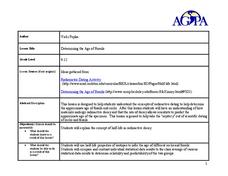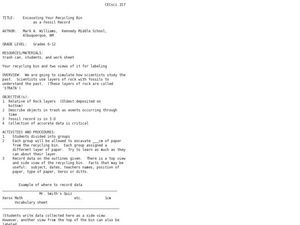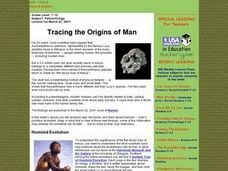Curated OER
Relative Dating - Telling Time Using Fossils
Students use fossil range charts to explain relative dating. They graph for ammonites, marine organisms that went extinct at the same time as dinosaurs.
Curated OER
Who Was Here First? Relative Dating
Students read about and complete question activities for the topic of relative dating. In this relative dating instructional activity, students read information for the topic and then complete two activities to further their...
Science 4 Inquiry
Layers and Laws: The Law of Superposition and Index Fossils
What can layers of rock teach us about the climate? Young scientists solve a mystery about who stole a cookie by applying the law of superposition. Then, they apply the same concept to solve a more difficult mystery, trying to determine...
Curated OER
Relative Dating-Telling Time Using Fossils
Students explore how to read fossil range charts. They develop an knowledge of the strengths and weaknesses of the fossil record. Students become familiar with the concepts index fossil and fossil range. Students use bar graphs to...
Virginia Department of Education
Determining Absolute Age
How can radioactive decay help date old objects? Learners explore half-life and radioactive decay by conducting an experiment using pennies to represent atoms. Young scientists graph data from the experiment to identify radioactive decay...
Curated OER
Examining the Fossil Record
Students create an evolutionary tree based on fossil morphology and their ages. In this fossil record lesson plan, students are given 23 pictures of fossil. They study their morphology and arrange the fossils by age and structures on a...
Curated OER
Fossil Inferences
Fourth graders use their knowledge about fossils to arrange fossil pictures in sequence from oldest to youngest. They explain how fossils can be used to make inferences about past life, climate, geology, and environments and discover...
Virginia Department of Education
Evidence of Evolution
What an impression fossils make! For this activity, aspiring paleontologists view fossils and construct a timeline to further understand how the lack of natural adaptation caused historical organisms to become extinct. While they...
Curated OER
Determining the Age of Fossils
Students examine the concept of radioactive dating. In this radioactive dating lesson, students investigate how to determine the ages of fossils and rocks as they learn about half-life radioactive decay.
Curated OER
Excavating Your Recycling Bin as a Fossil Record
Students explore how scientists examine the past and use rock layers with fossils to understand the past. In this excavation lesson plan students divide into groups and complete an activity.
Curated OER
PATTERNS IN TIME
Learners build a realistic sense of geological time, seek clues of transition fossils and find them. For this investigative lesson students complete several activities and worksheets on fossils.
Curated OER
How Old Is Mike?
Students examine the absolute dating of fossils, they use a list of names and ages to determine the difference between relative age and absolute age. They explore the relative age and absolute age of people and of fossils.
Channel Islands Film
Arlington Springs Man: Lesson Plan 2
West of the West's documentary Arlington Springs Man and a two-page scientific article about the same topic provide the text for a reading comprehension exercise that asks individuals to craft a one page summary of information gathered...
Curated OER
Tracing the Origins of Man
Learners discuss Hominid evolution through various websites and other resources. They examine online fossil skulls, discuss the use of tools by ancient man, and look for examples of sophisticated tools built by man.
Curated OER
Understanding the Geologic Timescale
Students identify and analyze how the geologic time scale was developed by investigating 11 periods of time and the vast expanse of time of the Earth's existence. They study their period, determine the important factors indicative to...
Curated OER
Tucson Children's Museum Dino Crossword
In this crossword puzzle, middle schoolers complete a crossword puzzle related to dinosaurs, the era in which dinosaurs lived, and about other animals that lived during that time period.
Curated OER
Simple Thermodynamics of Transportation
Students watch videos about various modes of transportation, they examine the energy transformations that occur in each, and they be introduced to the laws of thermodynamics.
Curated OER
Calibrate Peer ReviewTM: Petroleum Geology of the Persian Gulf Region
Students explore the origin and distribution of oil and gas in a region of global significance, the Middle East including the geologic history and the socio-political and environmental issues associated with hydrocarbon exploration and...
Curated OER
Human Prehistory
Young scholars discuss the history of humans. In this human history lesson, students describe how the placement of the continents changed and where the humans began and traveled to. They discuss interaction with Neanderthals and...
University of California
Ucmp: A Relative Dating Activity
An learning activity to help learners grasp the concept of relative dating and geologic time.
Science Education Resource Center at Carleton College
Serc: American Field Guide: Relative Dating Telling Time Using Fossils
This website integrates video footage and information with lesson plans and activities to teach students about the concept of relative dating. Students will graph a range chart for ammonites, determine the geologic age for several rocks,...
Other
Milton J. Rubenstein Museum: Determining the Age of Rocks and Fossils [Pdf]
This set of activities from the Milton J. Rubenstein Museum of Science & Technology has students investigating how relative dating and absolute dating methods are used to determine the age of rocks and fossils.
Utah Education Network
Uen: Fossil Inferences
Arrange fossil pictures in sequence from oldest to youngest.
Science Education Resource Center at Carleton College
Serc: Layer Cake Geology
Using a cake analogy, this activity teaches concepts such as: geologic time, rock layers, fossils, Law of Superposition, and relative dating. Activity can be modified to grade level and appropriate content for students,





















![Milton J. Rubenstein Museum: Determining the Age of Rocks and Fossils [Pdf] Lesson Plan Milton J. Rubenstein Museum: Determining the Age of Rocks and Fossils [Pdf] Lesson Plan](https://d15y2dacu3jp90.cloudfront.net/images/attachment_defaults/resource/large/FPO-knovation.png)
